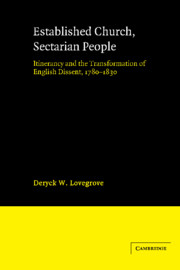 Established Church, Sectarian People
Established Church, Sectarian People Book contents
- Frontmatter
- Contents
- List of figures
- Preface
- Acknowledgements
- List of abbreviations
- 1 The Established Church and English Separatism
- 2 Itinerancy and Dissent
- 3 Preachers and sponsors
- 4 The academic leaven
- 5 Organization and infrastructure
- 6 Support and opposition
- 7 Criticism and legality
- 8 Developments and trends
- Conclusion
- Appendix A Journal of T[homas] Wastfield, June 1797–April 1798
- Appendix B Organizations active in itinerant evangelism
- Appendix C Baptismal statistics
- Notes
- Bibliography
- Index
4 - The academic leaven
Published online by Cambridge University Press: 13 October 2009
- Frontmatter
- Contents
- List of figures
- Preface
- Acknowledgements
- List of abbreviations
- 1 The Established Church and English Separatism
- 2 Itinerancy and Dissent
- 3 Preachers and sponsors
- 4 The academic leaven
- 5 Organization and infrastructure
- 6 Support and opposition
- 7 Criticism and legality
- 8 Developments and trends
- Conclusion
- Appendix A Journal of T[homas] Wastfield, June 1797–April 1798
- Appendix B Organizations active in itinerant evangelism
- Appendix C Baptismal statistics
- Notes
- Bibliography
- Index
Summary
Early itinerancy, with its total dependence upon individual initiative, developed unevenly and with little obvious co-ordination. But this phase was short-lived. By 1800 village preaching was becoming a national phenomenon, visible in the remotest rural communities, even in areas unaffected by Methodism. The completeness of this change points to the existence of a common factor; a source of inspiration more universal and capable of exerting more influence than those already identified. Neither the supervision of wealthy sponsors, nor the unifying power of the infant county associations, nor even the example set by early Methodism, are sufficient to explain the rapid expansion of the practice with all it signified for traditional Dissent. Given the prominence of newly ordained ministers among the itinerants, it seems a likely premise that the institutions responsible for their training were also the source of a sustained and systematic impulse towards evangelism. What is necessary, therefore, is to establish and examine their connection with itinerancy.
As suggested earlier, much of the criticism directed at the village preachers by supporters of the Establishment relied upon allegations of ignorance and lack of preparation, defects which reinforced the judgment of social unsuitability. With the ephemeral character of itinerant preaching and the passage of almost two centuries, it is difficult to know if the situation at Salisbury and Bath which attracted the condemnation of Wilberforce represented any more than local imprudence.
- Type
- Chapter
- Information
- Established Church, Sectarian PeopleItinerancy and the Transformation of English Dissent, 1780–1830, pp. 66 - 87Publisher: Cambridge University PressPrint publication year: 1988


